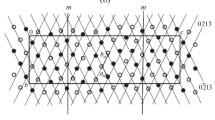Abstract
The aim of this paper is to give an algebraic formula for symmetry-adapted linear combinations avoiding intuitive or laborious projection operator techniques. By utilization of the tabulated Clebsch-Gordan coefficients and surface harmonics of the point-groups the symmetry-adapted linear combinations are given in formula (4). A five-step algorithm is proposed and the example of a tetrahedron worked out. The relation to methods using site symmetry is discussed.
Similar content being viewed by others
References
Cotton, F. A.: Chemical applications of group theory, 2nd Ed., Chapter 6. New York: Wiley-Interscience 1971
McWeeny, R.: Symmetry, pp. 129, 160 and 190. Oxford: Pergamon Press 1963
Melvin, M. A.: Rev. Mod. Phys. 28, 18 (1956)
Flurry, R. L.: Theoret. Chim. Acta (Berl.) 31, 221 (1973).
Bradley, C. J., Cracknell, A. P.: The mathematical theory of symmetry in solids, Chapter 2. Oxford: Clarendon Press 1972
Koster, G. F., Dimmock, J. O., Wheeler, R. G., Statz, H.: Properties of the thirty-two point groups. Cambridge, Mass.: M.I.T. Press 1963
Schläfer, H. L., Gliemann, G.: Einführung in die Ligandenfeldtheorie, 421. Frankfurt am Main: Akademische Verlagsgesellschaft 1967
Bishop, D. M.: Group theory and chemistry, Chapter 12. Oxford: Clarendon Press 1973
Cf. Ref. [3], p. 123, or Ref. [8], p. 124
Hamermesh, M.: Group theory. Reading, Mass.: Addison-Wesley 1962
Salthouse, J. A., Ware, M. J.: Point group character tables and related data. Cambridge: University Press 1972
Griffith, J. S.: The irreducible tensor method for molecular symmetry. Englewood Cliffs, N.J.: Prentice-Hall 1962
Ballhausen, C. J., Liehr, A. D.: J. Mol. Spectry. 2, 342 (1958) and Refs. therein
Barnes, J. A., Imman, G. W., Hatfield, W. E.: Inorg. Chem. 10, 1725 (1971); Lines, M. E., Ginsberg, A. P., Martin, R. L., Sherwood, R. C.: J. Chem. Phys. 57, 1 (1972)
Neumann, M. A., Trinh-Toan, Dahl, L. F.: J. Am. Chem. Soc. 94, 3383 (1972)
König, E., Kremer, St.: Theoret. Chim. Acta (Berl.) 32, 27 (1973), Sect. 3
Cf. Ref. [10], p. 152
Cf. Ref. [6], and Wybourne, B. G.: Classical groups for physicists, p. 222. New York: Wiley 1974
Author information
Authors and Affiliations
Rights and permissions
About this article
Cite this article
Fieck, G. Symmetry adaption reduced to tabulated quantities. Theoret. Chim. Acta 44, 279–291 (1977). https://doi.org/10.1007/BF00551170
Received:
Issue Date:
DOI: https://doi.org/10.1007/BF00551170




